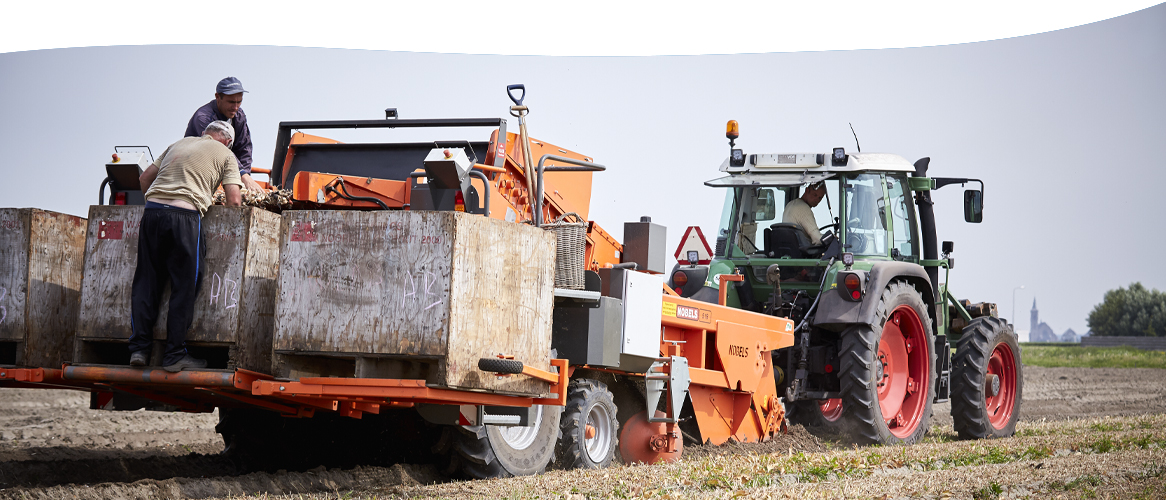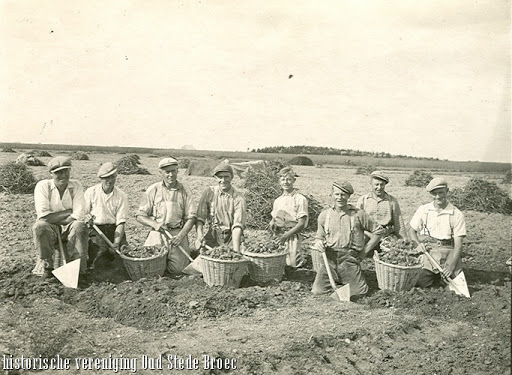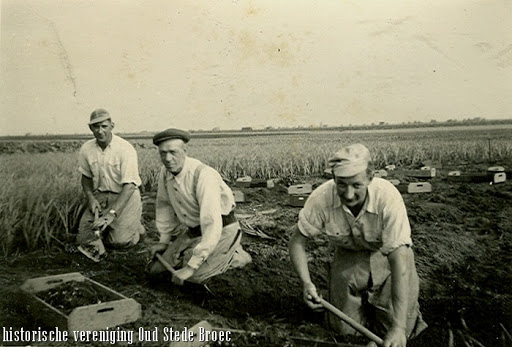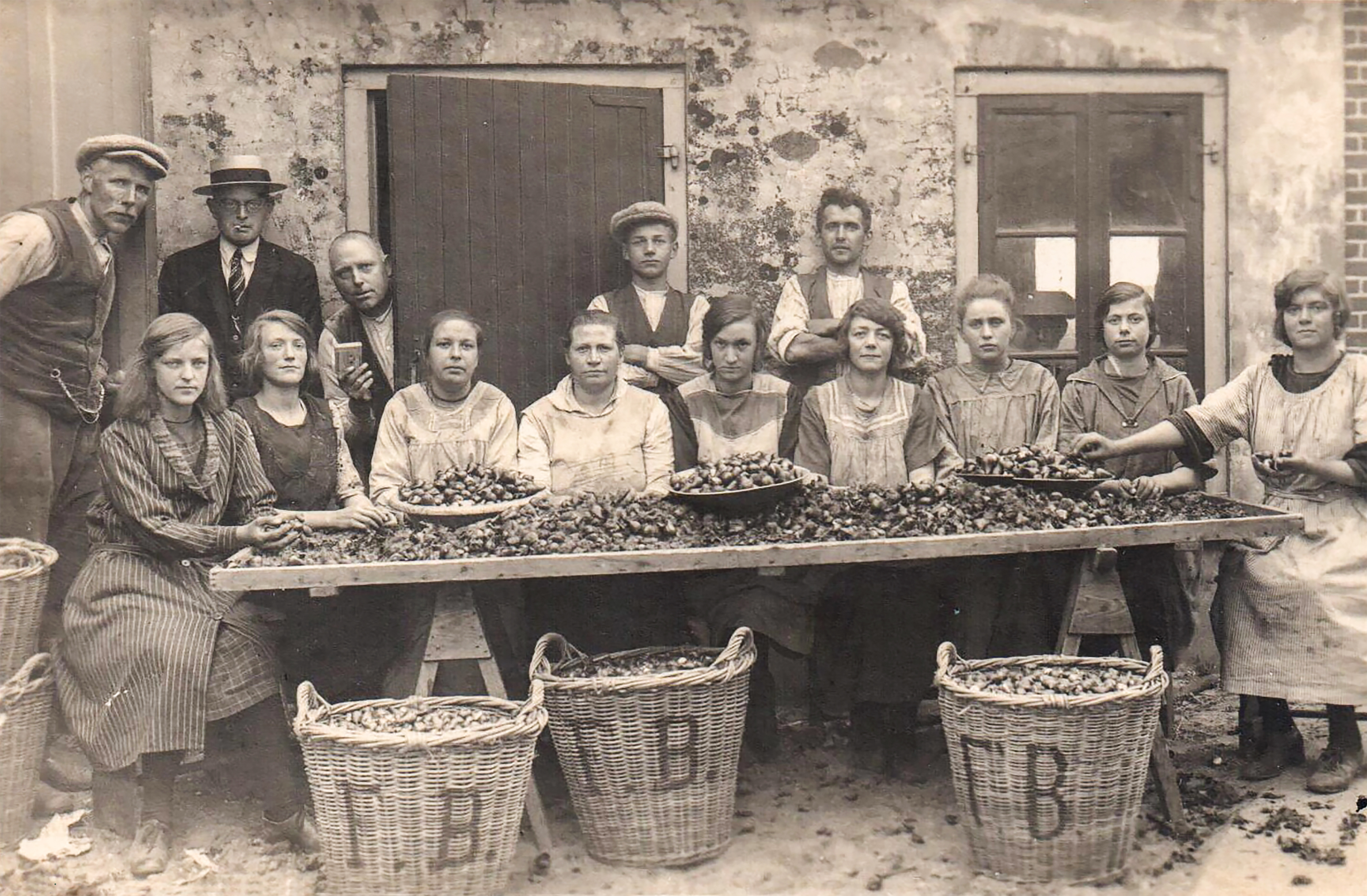Harvesting and further treatment

After weeks of flowering and growth, the bulbs now go out of the ground. In the past, this was done by hand, but nowadays this is done mechanically.
Before the bulbs are grubbed up, chopping is first done. With the chopping machine, the stems and leaves, which have completely finished flowering and dried out after heading, are shredded in order to make the field 'ripe for harvesting'. This makes harvesting a lot easier because then only the bulbs have to be harvested, instead of the bulbs with spent stems.
With the harvester, the bulbs are removed from the ground (grubbed up) and brought to the bulb shed in large wooden boxes for further processing. In the machine, the bulbs go over a sieve to remove the worst sand and clods of soil. A harvester can harvest up to 1.5 hectares of tulip bulbs per day!
The tulip bulbs that come unpeeled from the land in cubic boxes are placed in an enclosed space where warm air of around 25 °C is blown through. The box is closed with the foam-rubber cushions so that the warm air can spread well through the box so that the bulbs can dry well.
With the peeling machine, the bulbs are peeled mechanically. When bulb peeling, the roots, sheets and the small bulbs are removed. The small bulbs are the planting material for the coming year. Nowadays, 80% is peeled mechanically and 20% is still manually re-peeled on the assembly line. After peeling, the bulbs are sorted by size and counted. Sizes 10 to 12 are for trade. The small sizes serve as planting material for the next season.


In the past, things were different with various tools. With the V-hoe, the withered stems and leaves were first sheared off. With the truffle, the bulbs were manually removed from the ground. They were then gathered and transported in the bulb baskets to the bulb shed for further processing. A bouncing fork was used to scoop bulbs into baskets. The nubs at the end of the fork provide protection against damage. The bulbs were transported from the land with a bulb shed to the bulb barn for further processing.
In the past, baskets of peeled bulbs were carried to the attic of the bulb shed and deposited on shelves. All windows and grilles were opened so that the bulbs could dry by air circulation.
Tulip bulbs were peeled entirely by hand until 1990, as is the case with this peeling table. Complete school classes, families and large groups of women were peeling for 4 to 6 weeks during the summer holidays! Peeling... almost everyone from the Flower Bulb Region has done it at one time or another. It is hard work but can also be fun, because there is a lot of catching up to do, joking and singing!

More advice & inspiration
-
 Inspiration Create your own tulip oasis on your balcony
Inspiration Create your own tulip oasis on your balcony -
 Inspiration Welcome to the Tulip Experience
Inspiration Welcome to the Tulip Experience -
 Inspiration Mixing colors
Inspiration Mixing colors -
 Inspiration Plant instruction
Inspiration Plant instruction -
 Inspiration The dreamiest combinations
Inspiration The dreamiest combinations -
 Inspiration Involve grandchildren in the gardening
Inspiration Involve grandchildren in the gardening -
 Inspiration Tulip Experience Amsterdam
Inspiration Tulip Experience Amsterdam -
 Inspiration Why are the tulip heads being removed?
Inspiration Why are the tulip heads being removed? -
 Inspiration Harvesting and further treatment
Inspiration Harvesting and further treatment -
Inspiration Pealing, sorting, counting and warehousing
-
 Inspiration Packaging
Inspiration Packaging -
 Inspiration This is how we plant our bulbs.
Inspiration This is how we plant our bulbs. -
 Inspiration How does the tulip develop in winter.
Inspiration How does the tulip develop in winter. -
 Inspiration Create your own flower paradise!
Inspiration Create your own flower paradise! -
 Inspiration Exchange crops
Inspiration Exchange crops


